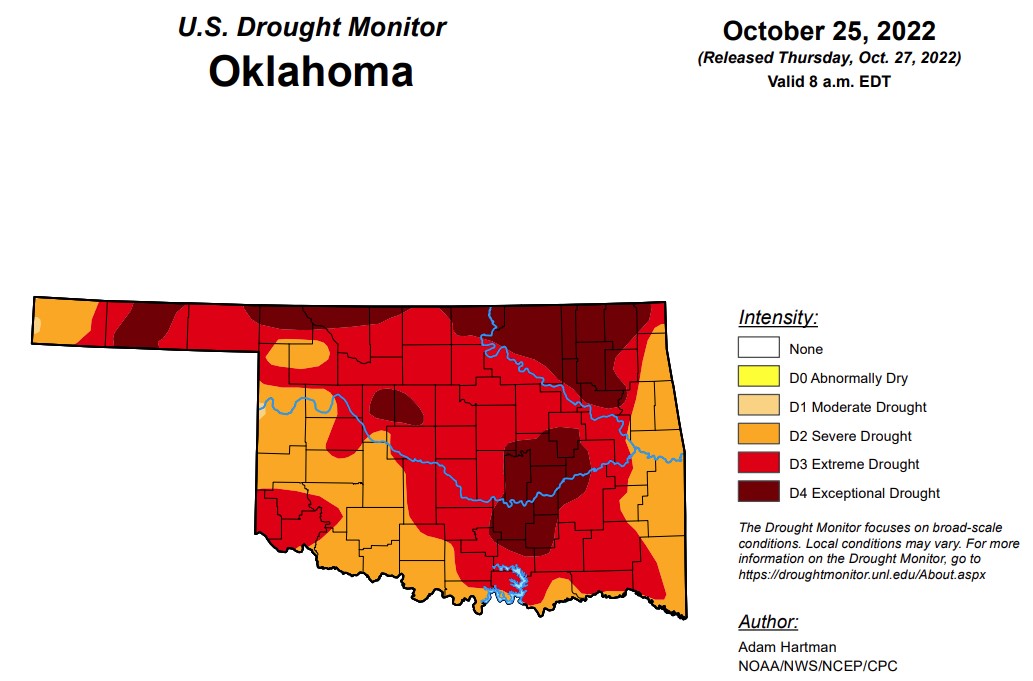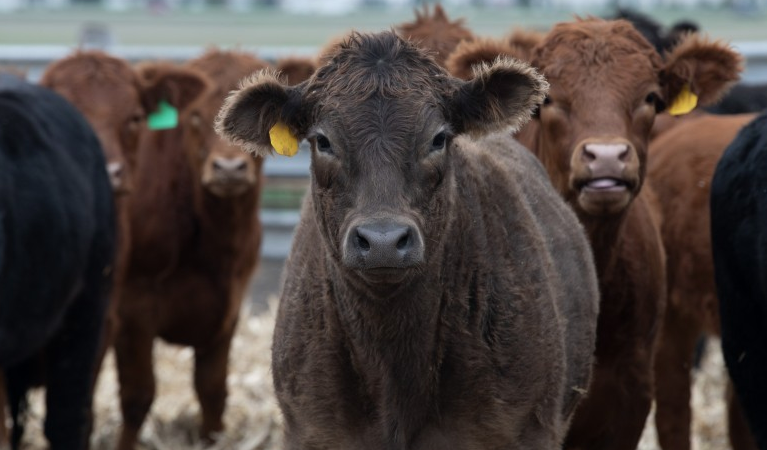Tue, 01 Nov 2022 03:27:44 CDT
Joplin Regional Stockyards
Mon Oct 31, 2022
AUCTION
This Week 5,692
Last Reported&n…

Nov 01
Tue, 01 Nov 2022 03:27:44 CDT
Joplin Regional Stockyards
Mon Oct 31, 2022
AUCTION
This Week 5,692
Last Reported&n…
Nov 01
Tue, 01 Nov 2022 03:24:54 CDT
Oklahoma National Stockyards
Mon Oct 31, 2022
AUCTION
This Week 6,500
Last Reported …
Oct 31
Mon, 31 Oct 2022 15:10:49 CDT
The U.S. Department of Agriculture and the Oklahoma Department of Agriculture are now putting the Daily Cash Grain Report into a PDF format – we are saving that PDF and archiving them for today’s specific report. To see today’s update, click on the PDF report link at the bottom of this story.
In addition to the PDF of the daily report, you can also listen to the Cash Grain Report by calling 405-621-5533. Push 2 for the grain report.
Click here: 04886_OklaCashGrain10312022.pdf
Oct 31
Mon, 31 Oct 2022 14:31:36 CDT


Listen to today’s report with Justin Lewis, by clicking or tapping on the LISTEN bar
Justin Lewis of KIS Futures has all the details on today’s agricultural markets for RON listeners, below.
Oct 31
Mon, 31 Oct 2022 14:26:01 CDT


There’s a new blog post out on the Southern Plains Perspective by Clay Pope. Read Below!
We got rain!!! I had over an inch and half in my gage last week! Some folks in Southern Oklahoma got more than that! Great news, at least in Oklahoma, right?
Wrong.
Leave it to our good friends at the Oklahoma MESONET to come up with stats showing us how, even with last week’s rain, how dry it is in all of Oklahoma…..
And, as they so “helpfully” point out, the drought actually started much earlier than June 29 of this year…..so they showed us the stats for the last 365 days…….
And while I am still happy for the rain (even though the MESONET folks remind me how behind we are here in Oklahoma on moisture) I take a look at the drought monitor and see just how bad it still is, especially in Northern Oklahoma and Southern Kansas-remember, the darker the color, the worse the drought conditions…….
That is not a good look……
Still, conditions in Texas are better than they were earlier this summer and the folks in parts of Southwest Oklahoma have seen an improvement. Even with that little bit of positive news we have to remember that with the onset of a “triple dip” La Nina this drought could very well just be getting started.
Successful Farming Magazine put out a drought story just last week titled “U.S. IS DRIEST IN A DECADE, AS DROUGHT MOVES EASTWARD.” This article discussed how we are in for a “triple dip” La Nina for the first time since 2012. We all remember 2012, right?
The story went on to say that an article penned by Rippey for the Journal Weather and Climate Extremes said that the 2012 drought was a “once-in-a-generation crop calamity” that grew out of back-to-back La Niña weather patterns and caused $30 billion in damages, mostly agricultural. La Niña weather patterns typically bring drier-than-usual weather to the U.S. southern tier. The summer of 2012 was the second hottest in U.S. history, trailing only 1936, and the driest since 1988, another drought year.
“More than one-quarter of the corn and sorghum was lost to the drought,” wrote Rippey. More than three-fourths of the U.S. cattle herd and two-thirds of hay territory was in drought.
The article went on to say that a week ago, NOAA forecasters said the United States would go through its third La Niña winter in a row, suggesting little relief for winter wheat or low water on the Mississippi.
The story quoted Jon Gottschalck of NOAA’s Climate Prediction Center as saying “Drought conditions are now present across approximately 59% of the country, but parts of the western United States and southern Great Plains will continue to be the hardest hit this winter. With the La Niña climate pattern still in place, drought conditions also may expand to the Gulf Coast.”
Lovely.
Again, as a reminder, if you have not checked in with your local USDA Service Center to see what kind of drought assistance is available, you need to do so! Not only is there help available from USDA (we wrote about some of this in an earlier blog ), but some states have taken action on drought assistance too (Oklahoma for example, has engaged its emergency drought fund). You also can check out a couple of videos we did a while back with some of the folks at NRCS with some tips on dealing with dry conditions here and here.
I promise next week I’ll write about something else….maybe.
To view this blog post at the Southern Plains Perspective, click here.
To view more blog posts, podcasts and content at the Southern Plains Perspective, click here.

Oct 31
Mon, 31 Oct 2022 13:39:51 CDT
Oklahoma State University recently honored a distinguished group of individuals who have brought distinction to the Ferguson College of Agriculture and have demonstrated a continuing commitment to agr…
Oct 31
Mon, 31 Oct 2022 13:24:31 CDT


The latest Farm Bureau Newsline Podcast talks about the impacts of Drought on Cattle Supplies.
Data released this month from the Department of Agriculture shows drought is having an impact on cattle markets. Micheal Clements and American Farm Bureau Federation Economist Bernt Nelson shares more from the Cattle on Feed report.
” I think we can really call this report bullish, with total cattle on feed coming in right around 11.4 million, down one percent from this time in 2021. Placements are a little bit over two million head, this is four percent below this time last year in 2021.Said Nelson.
Placements were down the most in drought-stricken states. “This is likely due to some tighter calf supplies along with higher feed and input costs amplified by the drought conditions. We’ve seen marketings for fed cattle totaling 1.86 million head for September, this is four percent above this time in 2021. Now, when we really see marketing high and placements become lower over a longer drawn out period of time, this really signals that lower cattle supplies are in the future.”
Additionally, USDA’s Livestock Slaughter Report shows higher beef slaughter numbers.
To hear the complete conversation between Clements and Nelson, click or tap below:
Oct 31
Mon, 31 Oct 2022 13:10:26 CDT
The American Soybean Association’s World Initiative for Soy in Human Health Program and U.S. Soybean Export Council representatives join the U.S. Department of Agriculture’s agribusiness trade mission in Nairobi, Kenya, and Zanzibar, Tanzania on Oct. 31 – Nov. 4. Their participation reinforces the importance of U.S. soy protein for trade, development and food security in sub-Saharan Africa.
WISHH Chair Roberta Simpson-Dolbeare, an Illinois soybean farmer, is one of the six U.S. soy organization representatives on the trade mission led by USDA Deputy Secretary Jewel Bronough. “Kenya was one of the first countries where U.S. soybean growers sent WISHH to start building relationships there when we founded WISHH 22 years ago. It is exciting to see this wise, long-term investment has taken root through WISHH’s strategic partnerships with producers of high-quality soy-based foods and feeds,” said Simpson-Dolbeare.
USSEC Executive Committee Member Lance Rezac, a Kansas soybean farmer and United Soybean Board director, also joins the trade delegation. “With Kenya having recently authorized the import of GMO plant material, this mission is an especially important opportunity to engage with key stakeholders and share the insights on U.S. Soy’s value and reliability,” said Rezac, “U.S. Soy farmers are proud of the high-quality, sustainable product we grow and hope to help foster improved protein sources in the region, whether it’s through direct soy food consumption or through animal agriculture.”
WISHH and USSEC have collaborated on market access for the region. Joining the two farmer-leaders are WISHH Executive Director Gena Perry and New Business Lead Austin Leefers, along with USSEC Executive Director of Market Access & Strategy Rosalind Leeck.
According to the July 2022 USDA report, Opportunities for U.S. Feed Ingredients and Processed Products in Kenya, “Soybean meal has had the most consistent growth and is expected to increase further as livestock capacity increases. Grains for feed are mostly domestically produced. However, as the price of feed production increases, Kenya is expected to look outside of domestic products to supplement demand. In 2021, soybean meal reached its second-highest imports in history at $1 million, a 97% increase from 2017. Soybean imports have been minimal and volatile but offer potential. Over the past five years, imports have ranged between $30 thousand (2021) to $8.5 million (2020) with million-dollar soybean imports coming from Ukraine”
About WISHH: WISHH connects trade and development across global market systems. Visionary U.S. soybean growers lead WISHH’s work, which improves global food security and builds economic growth through the power of soy protein for human foods and livestock and aquaculture feeds. WISHH’s strategic partnerships span 28 countries in sub-Saharan Africa, Asia and Latin America. Connect with WISHH at www.wishh.org and https://www.linkedin.com/company/wishh
About USSEC: The U.S. Soybean Export Council (USSEC) focuses on differentiating, elevating preference, and attaining market access for the use of U.S. Soy for human consumption, aquaculture, and livestock feed in 80+ countries internationally. USSEC members represent the soy supply chain including U.S. Soy farmers, processors, commodity shippers, merchandisers, allied agribusinesses, and agricultural organizations. USSEC is funded by the U.S. soybean checkoff, USDA Foreign Agricultural Service (FAS) matching funds, and industry. Please visit https://ussec.org/ for the latest information, resources, and news about USSEC and U.S. Soy internationally.
Oct 31
Mon, 31 Oct 2022 12:13:49 CDT
The National Dairy Farmers Assuring Responsible Management (FARM) Program last week announced the winners of the second annual FARM Excellence Awards.
Through these awards, the FARM Program reco…
Oct 31
Mon, 31 Oct 2022 12:08:01 CDT
The Secretary of the State Election Board is encouraging voters who have requested absentee ballots to mail those ballots back as soon as possible to ensure they are received by their County Election …